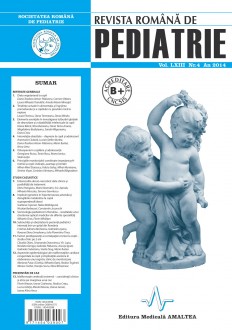SELECT ISSUE

Indexed

| |

|
|
|
| |
|
|
|

|
|
|
|
|
|
|
HIGHLIGHTS
National Awards “Science and Research”
NEW! RJP has announced the annually National Award for "Science and Research" for the best scientific articles published throughout the year in the official journal.
Read the Recommendations for the Conduct, Reporting, Editing, and Publication of Scholarly work in Medical Journals.
The published medical research literature is a global public good. Medical journal editors have a social responsibility to promote global health by publishing, whenever possible, research that furthers health worldwide.
ENTEROCOLITA ULCERO-NECROTICA: DATE CLINICE SI POSIBILITATI DE TRATAMENT
Elena Hanganu, Maria Stamatin, S.G. Aprodu, Mihaela Moscalu and Simona Gavrilescu
ABSTRACT
Obiective. Identificarea corelaţiilor între evoluţia clinică a nou-născuţilor cu enterocolita ulceronecrotică (EUN) şi stadiul de boală, factorii de risc asociaţi, respectiv tipul de tratament utilizat.
Material şi metodă. S-a realizat un studiu retrospectiv pe o perioadă de 6 ani pe baza cazuisticii Centrului Regional de Terapie Intensivă Neonatală „Cuza Voda“ şi s-au identificat 205 cazuri de enterocolită ulceronecrotică dintr-un total de 6.183 de nou-născuţi îngrijiţi aici. Bolnavii au fost împărţiţi în loturi de studiu în funcţie de vârsta de gestaţie (VG), respectiv greutatea la naştere (GN). Protocolul de analiză s-a realizat pe baza unei fişe de lucru care a cuprins datele epidemiologice ale pacienţilor, factorii de risc, tipul alimentaţiei, vârstă în momentul diagnosticului, stadiul de boală conform clasificării Bell, modalitatea de tratament (medical, chirurgical sau mixt), complicaţiile înregistrate şi evoluţia pacienţilor. Prelucrarea statistică a datelor s-a făcut utilizând programul SPSS Statistics 20.
Rezultate. Enterocolita ulceronecrotică a avut o frecvenţă de 3,3% în lotul studiat şi a fost diagnosticată la nounăscuţii prematuri în 75,6% dintre cazuri. VG medie în grupul de studiu a fost de 33 săptămâni. GN medie a fost de 1.896 g, cu 43% dintre cazuri în grupul cu greutate foarte mică la naştere (VLBW) şi 31,2% în grupul cu greutate mică la naştere (LBW). Incidenţa procentuală a factorilor de risc a fost următoarea în ordinea frecvenţei: persistenţa canalului arterial 19,5%, asfixia perinatală 13,7%, detresa respiratorie 100% dintre cazuri. 75,5% dintre cazuri au fost tratate şi externate din CRTIN, 16,6% dintre cazuri au fost transferate în Clinica de Chirurgie Pediatrică a Spitalului „Sf. Maria“ şi 3,9% au decedat la CRTIN. Din cele 34 de cazuri transferate, 19 cazuri au fost tratate chirurgical: 8 cazuri cu drenaj peritoneal (DP), 8 cazuri cu laparotomie primara (LAP) şi 3 cazuri cu LAP şi DP. Rata supravieţuirii în acest grup a fost 2,4%, iar pentru grupul cu tratament medical a fost 4,9%.
Concluzii. Prematuritatea se corelează statistic cu stadii avansate de enterocolită în momentul diagnosticului. Modalitatea de tratament chirurgical aleasă (drenaj peritoneal sau laparotomie) nu influenţează rezultatele, iar alimentaţia enterală precoce cu formula de lapte este cel mai important factor de risc pentru apariţia EUN, urmat de vârsta de gestaţie şi greutatea foarte mică la naştere.
Cuvinte cheie: enterocolită ulceronecrotică, nou-născut, posibilităţi de tratament
